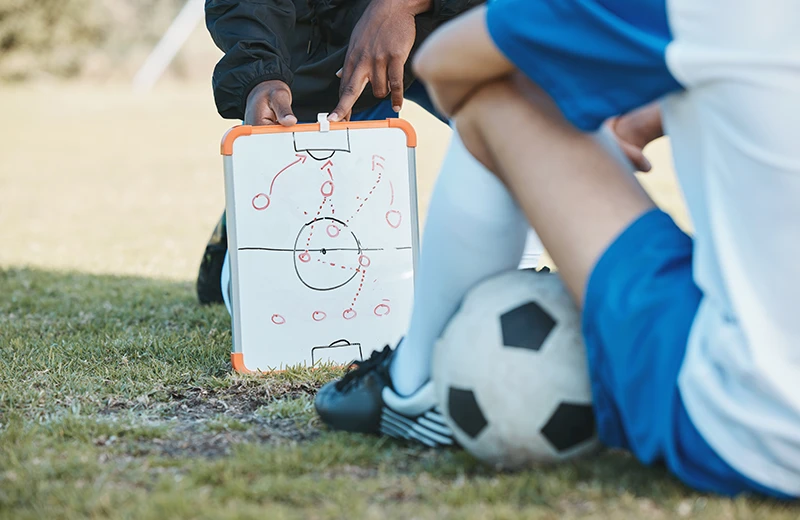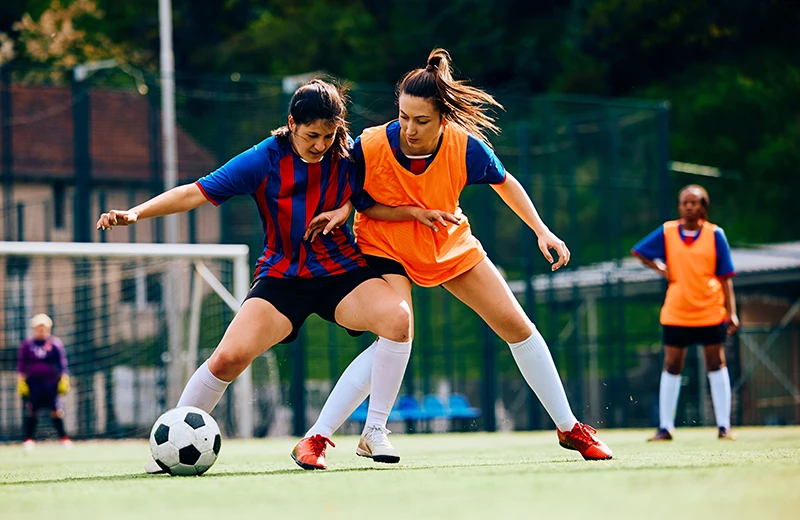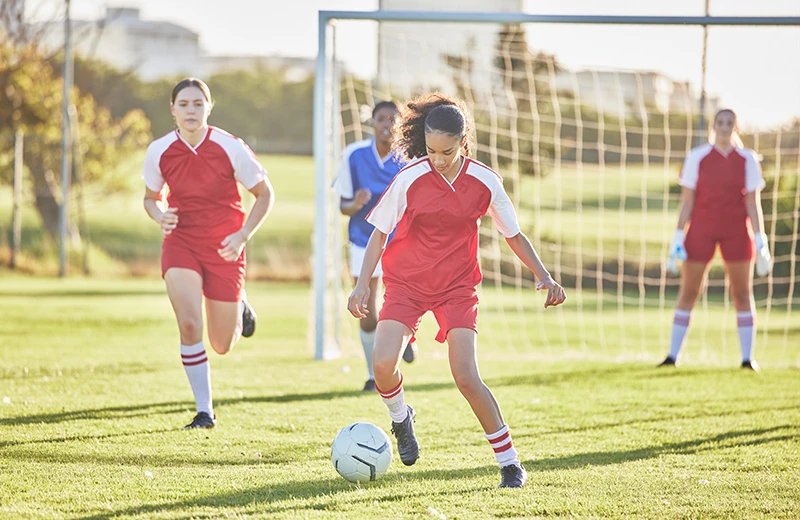Soccer Positions Explained: A Parent’s Guide

As you are following your child into the exciting world of soccer you are also learning how to be a soccer parent. You are figuring out the soccer rules and learning important soccer terms that will help you follow what is happenning on the field. Very soon, you will be able to have a soccer conversation with your child and sound like a pro.
When your child steps onto the soccer field, they might play a variety of roles depending on their position. Each position requires different skills and responsibilities, and understanding these will help you follow the game better and support your child’s development. Here’s a guide to the different soccer positions and what each one involves.
1. Goalkeeper (GK)
The goalkeeper is the most unique position on the field. Here are the key duties and attributes:
Primary Role: The goalkeeper’s job is to stop the ball from entering the goal. They are the only player allowed to use their hands, but only within the penalty area.
Skills Needed: Quick reflexes, good hand-eye coordination, bravery, and the ability to communicate with defenders. Goalkeepers also need to have strong kicking skills for distributing the ball after saves.
Special Rule: Outside of the penalty box, goalkeepers must follow the same rules as any other player, meaning they can’t use their hands.
Youth Soccer Adaptations: In younger leagues (e.g., U6), there may be no goalkeepers to focus on developing field skills for all players.

2. Defenders
Defenders are tasked with protecting their goal by stopping the opposing team’s attacks. Here are the different types of defenders and their responsibilities:
Center-Backs (CB)
Primary Role: Center-backs are positioned centrally in front of the goalkeeper and are responsible for stopping opposing forwards from getting close to the goal. They often make crucial tackles and clearances.
Skills Needed: Physical strength, strong tackling, heading ability, and a good understanding of positioning.
Communication: Center-backs usually take on a leadership role in organizing the defense, making sure that their teammates are in the right positions.

Full-Backs (LB/RB)
Primary Role: Full-backs play on the left or right side of the defense. Their job is to defend against wingers (the opposition’s wide attackers) and prevent crosses into the penalty area.
Skills Needed: Full-backs need speed and stamina since they often run up and down the sidelines. They also need good tackling and crossing abilities because they frequently support the attack by overlapping with wingers.
Youth Soccer Adaptations: In smaller-sided games (e.g., 7v7 or 9v9), full-backs may have more offensive responsibilities as there are fewer players on the field.
Wing-Backs (LWB/RWB)
Primary Role: Wing-backs are a hybrid between full-backs and midfielders. They operate along the entire sideline, defending against attackers and supporting the offense by providing width. This position is often used in formations with three center-backs.
Skills Needed: Wing-backs must have great stamina, speed, and crossing skills. They also need to be comfortable defending and attacking.
3. Midfielders
Midfielders are the engine of the team. They play a key role in both defending and attacking. Here are the different types of midfielders:

Defensive Midfielder (CDM)
Primary Role: Defensive midfielders sit just in front of the defenders and are tasked with breaking up the opposition’s attacks. They often intercept passes and make tackles to win the ball back.
Skills Needed: Defensive awareness, tackling ability, and good positioning. A strong defensive midfielder also needs good passing skills to start counter-attacks after winning the ball.
Youth Soccer Tip: Defensive midfielders often go unnoticed by parents because they don’t score many goals, but their contribution is crucial for keeping the team balanced.
Central Midfielder (CM)
Primary Role: Central midfielders are positioned in the middle of the field and are often the link between defense and attack. They control the tempo of the game by passing, tackling, and distributing the ball to other players.
Skills Needed: Vision, passing accuracy, stamina, and defensive awareness. Central midfielders are often the most well-rounded players on the field because they need to contribute to both defense and attack.
Youth Soccer Adaptations: In younger age groups, central midfielders may also be expected to score goals or defend more actively due to fewer players on the field.
Attacking Midfielder (CAM)
Primary Role: Positioned behind the forwards, attacking midfielders focus on creating scoring opportunities. They are often the playmakers, controlling the attack by making passes, taking shots, and dribbling through defenses.
Skills Needed: Creativity, dribbling, shooting, and vision. Attacking midfielders are often highly skilled with the ball and need quick decision-making abilities.
Wide Midfielders (LM/RM)
Primary Role: Wide midfielders operate on the left or right side of the field, providing width to the attack. They often dribble past defenders and send crosses into the penalty area.
Skills Needed: Speed, dribbling, crossing, and the ability to track back and help the defense. Wide midfielders need to be effective both offensively and defensively.
Youth Soccer Adaptations: In youth soccer, wide midfielders may also be called upon to cover more ground, especially in smaller-sided games.
4. Forwards
Forwards, also known as strikers or attackers, are the primary goal scorers on the team. Here are the different types of forwards:

Center-Forward (CF)
Primary Role: Center-forwards are positioned closest to the opponent’s goal and are tasked with finishing attacking moves by scoring goals. They often stay near the penalty box, looking for opportunities to shoot.
Skills Needed: Strong shooting, positioning, heading, and the ability to play with their back to goal. Center-forwards also need good ball control and passing ability to involve other players in the attack.
Youth Soccer Tip: At younger levels, forwards might rotate between attacking and defending roles as the game focuses more on development than specialization.
Wingers (LW/RW)
Primary Role: Wingers play on the left or right flanks and are responsible for stretching the opposing defense. They use their speed to dribble past defenders and deliver crosses into the box for other attackers to finish.
Skills Needed: Speed, dribbling, crossing, and stamina. Wingers must also be able to cut inside and take shots when the opportunity arises.
Youth Soccer Tip: In smaller-sided games, wingers may also play more centrally, making them key goal-scoring threats.
5. Hybrid Roles
Some positions combine the responsibilities of two roles. For example:
False 9: A center-forward who drops deeper into midfield to create space and confusion for the opposition’s defense.
Inverted Winger: A winger who plays on the opposite side of their strong foot (e.g., a right-footed player on the left wing) to cut inside and shoot rather than cross.
How Soccer Positions Vary by Age Group
In younger age groups, positions are often less rigid. Coaches encourage players to try out different roles to develop a well-rounded understanding of the game. For example, in U6 and U8 soccer games, all players might take turns playing forward, midfield, and defense, allowing them to build skills in every area. As players progress to U10 and beyond, positions become more specialized, and kids can begin focusing on specific roles that fit their strengths.
Conclusion
Understanding soccer positions can greatly enhance your experience as a parent watching from the sidelines. Knowing where your child is playing and what’s expected of them will help you support their development and celebrate their progress in a meaningful way. Whether they’re making a crucial save as a goalkeeper or setting up a goal as a midfielder, every position is important, and every player contributes to the team’s success.
As your child grows and gains more experience, they may find their favorite position, but for now, encourage them to explore different roles, learn new skills, and most of all, have fun!
